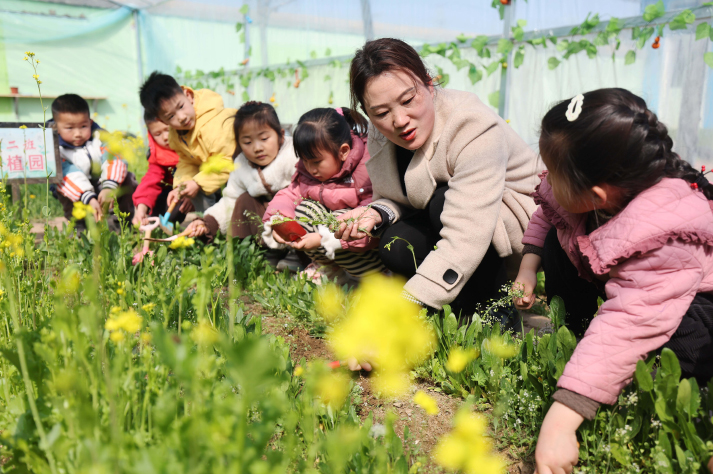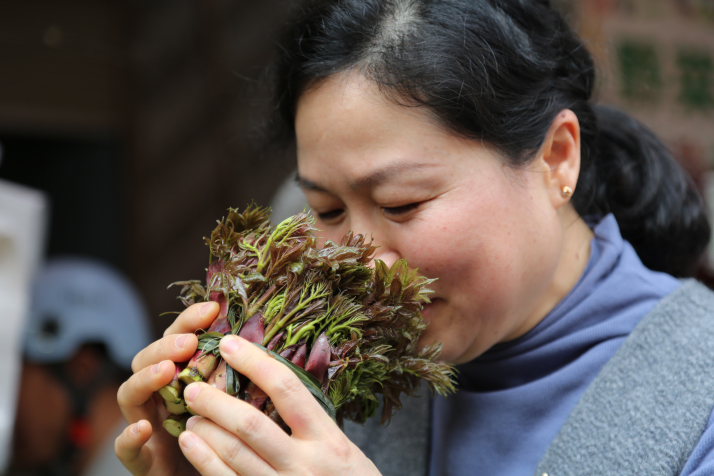| China |
| The rising popularity of wild vegetables in China | |
|
|
 Children from a kindergarten in Linyi, Shandong Province learn to forage for wild vegetables with their teacher on March 19 (XINHUA)
When listing scholar tree flowers in his online shop, Lin Jian was confident they would sell out quickly, as they had in previous years. This year, he had gathered only 5 kg of the flowers, reserving 500 grams for his own family and offering the remaining 4.5 kg for sale. Prior to the listing, he had already received numerous inquiries from customers eager to know when the flowers would be available. Priced at 18 yuan ($2.5) for 250 grams, the scholar tree flowers were sold out within 10 minutes. "They sold even faster than last year," he told Beijing Review. Having run a farm on the outskirts of Beijing for nearly a decade, Lin has become well-versed in riding the seasonal fluctuations of demand. Among the items that see a spike in popularity each spring are shepherd's purse and Chinese toon leaves, both of which are traditional wild vegetables in the northern parts of China. "Demand for them has surged in recent years," he said.  A buyer smells wild vegetables at a farmers’ market in Mengzi, Yunnan Province on March 16 (XINHUA)
Taste of spring Beyond purchasing these wild vegetables, some individuals are keen on foraging for them. Jia Ping, a 40-year-old, enjoys venturing into the wild with friends to gather these springtime treasures. "Growing up, my mother often took me to forage for wild vegetables in nature, leaving me with vivid and cherished childhood memories," she told Beijing Review. "Continuing this tradition, I now take my daughter along to forage. It's my hope that she, too, will hold these experiences close to her heart." Her daughter has acquired substantial knowledge of wild vegetables, learning to differentiate between various types. More than a trip down memory lane, foraging for wild vegetables diversifies food items on the dining table. "These wild vegetables are fresh, seasonal and untouched by fertilizers," Jia Ping explained. "They align with many people's growing preference for eating healthily." Their preparation methods for these vegetables are often passed down through generations. Some are used in fillings for dumplings, others are sautéed with beaten eggs, some can be enjoyed raw with a dipping sauce, and others are steamed after being blended with corn and wheat flour. Lin shared his expertise with customers on how to perfectly fry scholar tree flowers with eggs. "First, you need to blend the flowers with beaten eggs before frying," he advised. "Avoid frying the flowers directly in the pan, as this can diminish their delicate flavor." He recommended sprinkling just a little salt to enhance the flowers' natural sweetness and floral notes. Jia's favorite wild vegetable is the Chinese toon leaf. She has developed several methods for preparing it—frying it with eggs, using it as dumpling filling, or curing it to mix with handmade noodles. "Although these wild vegetables are seasonal, we have numerous ways to preserve them, such as drying or salting, allowing us to enjoy their flavors even in winter," she said. Some enthusiasts, like Wang Xin from Nanjing in Jiangsu Province, have taken their passion a step further. Having foraged for wild vegetables for over six years, Wang began organizing wild vegetable picking groups last year and the initiative quickly gained popularity. Within a year, the group expanded to include more than 3,000 members, predominantly women ranging from their 20s to 50s, many of whom bring their children along for some family quality time. "Digging for wild vegetables is incredibly fun," she shared with Hubei Daily. "It's like opening mystery boxes—you never know what you'll find next. You leave with an empty basket and return with it full to the brim. It's a profound sense of accomplishment." Initially, the group organized foraging activities once or twice a month; but this year, they increased the frequency to once or twice a week. Wang meticulously created a detailed Excel spreadsheet that lists the types and locations of various vegetables around the city. "For different vegetables, we need different tools for picking," she noted. "I've now identified over 20 types of wild vegetables and am still exploring more." Cultivating the wild Recognizing the business potential of wild greens, farmers have begun exploring ways to cultivate them on a larger scale. Zhu Xinwei, who had extensive experience in the agricultural supply business, returned to his hometown in Yucheng County, Henan Province, in 2010 to engage in large-scale cultivation of the wild vegetable shepherd's purse. "Local farmers typically grow corn and winter wheat," Zhu told People's Daily. "Corn is planted in June, harvested in September, and winter wheat is sown in December and harvested the following June, leaving the land idle for over two months each year. We utilize this idle period to plant shepherd's purse." Starting with 100 acres, Zhu has expanded to 350 acres in recent years. This year, he received numerous orders before even beginning to plant and plans to increase his cultivation area to 510 acres. He noted that with yield exceeding 4,000 pounds per acre and a market price of over 1 yuan ($0.14) per pound, planting an additional crop of shepherd's purse can boost income by about 2,000 yuan ($277) per acre after costs, compared to solely growing corn and wheat. In Yunnan, known for its diversity of wild vegetables, farmers in the rural areas of Linxiang Prefecture have moved beyond traditional small-scale foraging to cultivate these plants on a larger scale. Wang Chengrong, a local farmer, began planting huoliancai, a local wild green, the name of which literally translates to "fire sickle" in English, on his farm in 2016 with support from the local government, which provided seedlings and technical guidance. Wang told Lincang News that he used to forage for wild vegetables each spring to sell at the market, which provided a decent income. Now, like other villagers, Wang has shifted to cultivation, significantly increasing his earnings. His 10-acre farm, dedicated entirely to huoliancai, now has steady buyers, and he finds this more profitable than other crops, with last year's sales totaling 60,000 yuan ($8,300). "Though there's a significant initial investment in cultivating wild vegetables on a large scale, the technical requirements are minimal. Ordinary farmers can manage with just basic training," Tang Yongmei, who is in charge of promoting huoliancai growing techniques among local farmers, told Lincang News. She said that, previously, wild vegetables were pricier due to their longer production cycle and limited availability. Now, as cultivation has expanded, so have yield and profitability. "As market acceptance grows and consumers are more willing to spend on wild vegetables, farmers are increasingly motivated to cultivate them, leading to a steady increase in supply each year," she said. Copyedited by G.P. Wilson Comments to yuanyuan@cicgamericas.com |
|
||||||||||||||||||||||||||||
|
